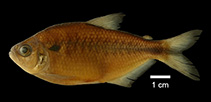Astyanax boliviensis Ruiz-C., Román-Valencia, Taphorn, Buckup & Ortega, 2018
Upload your photos and videos
Pictures | Google imageAstyanax boliviensis
Picture by Ruiz-C., R.I. et al., 2018
Pictures | Google imageAstyanax boliviensis
Picture by Ruiz-C., R.I. et al., 2018
Common names from other countries
Classification / Names Nombres comunes | Sinónimos | Catalog of Fishes(Género, Especie) | ITIS | CoL | WoRMS | Cloffa
> Characiformes (Characins) > Characidae (Characins; tetras) > Stethaprioninae
Etymology: Astyanax: The name of Astyanax, Hector´s son in the Greek mythology (Ref. 45335); boliviensis: Named for the country where the type series was collected, Bolivia.
Eponymy: Astyanax was the son of Hector in Greek mythology. See Homer’s Iliad for details. The reasoning for its use for a genus of characins is not explained. (Ref. 128868), visit book page.
Etymology: Astyanax: The name of Astyanax, Hector´s son in the Greek mythology (Ref. 45335); boliviensis: Named for the country where the type series was collected, Bolivia.
Eponymy: Astyanax was the son of Hector in Greek mythology. See Homer’s Iliad for details. The reasoning for its use for a genus of characins is not explained. (Ref. 128868), visit book page.
Environment: milieu / climate zone / depth range / distribution range Ecología
; agua dulce bentopelágico. Tropical
Distribución Países | Áreas FAO | Ecosistemas | Ocurrencias, apariciones | Point map | Introducciones | Faunafri
South America: Upper Amazon River Basin of Bolivia and Peru.
Tamaño / Peso / Age
Short description Claves de identificación | Morfología | Morfometría
Radios blandos dorsales (total) : 9. This species which is a member of the orthodus species-group of Astyanax differs from other species of the group in having lines extending from the tips of the chevrons on both the anterior and posterior extremes (proximal and distal sections of chevron extensions), forming etensions between the chevrons (vs. chevrons without lines extending from their tips), except A. moorii which is distinguished by the number of lateral-line scales 39-42 (vs. 44–50); also differs from A. moorii in the upper jaw length > 34% HL (vs. < 47% HL); further differs from A. villwocki by the absence of a dark stripe on the sides of the body (vs. with dark lateral stripe or anterior prolongation of the caudal peduncle spot extending over the silvery lateral stripe); differs from orthodus, embera, yariguies in having a distinct rhomboidal caudal-peduncle spot with a short, anterior, prolongation that does not surpass a vertical through the anal-fin origin (vs. spot on caudal peduncle a short polygon shape not surpassing the posterior tip of the anal fin in orthodus, embera and spot on caudal peduncle elongated as a stripe, continuing anteriorly to humeral region in A. villwocki; differs from A. bopiensis in having , 4 teeth extending over less than one third of the maxillary (vs. > 5 teeth extending over more than two thirds of the maxillary) (Ref. 119406).
Life cycle and mating behavior Madurez | Reproducción | Puesta | Huevos | Fecundidad | Larva
Main reference
Upload your references | Referencias | Coordinador | Colaboradores
Ruiz-C., R.I., C. Román-Valencia, D.C. Taphorn, P.A. Buckup and H. Ortega, 2018. Revision of the Astyanax orthodus species-group (Teleostei: Characidae) with descriptions of three new species. European Journal of Taxonomy 402:1-45. (Ref. 119406)
Threat to humans
Harmless
Human uses
FAO(Publication : search) | FishSource |
Más información
Trophic ecology
componentes alimenticios
Composición de la dieta
consumo de alimento
Food rations
Despredadores
componentes alimenticios
Composición de la dieta
consumo de alimento
Food rations
Despredadores
Ecology
Ecología
Home ranges
Ecología
Home ranges
Population dynamics
Coeficiente del crecimiento para
Max. ages / sizes
Length-weight rel.
Length-length rel.
Length-frequencies
Mass conversion
Reclutamiento
Abundancia
Coeficiente del crecimiento para
Max. ages / sizes
Length-weight rel.
Length-length rel.
Length-frequencies
Mass conversion
Reclutamiento
Abundancia
Life cycle
Reproducción
Madurez
Fecundidad
Puesta
Spawning aggregations
Huevos
Egg development
Larva
Dinámica larvaria
Reproducción
Madurez
Fecundidad
Puesta
Spawning aggregations
Huevos
Egg development
Larva
Dinámica larvaria
Anatomy
Superficie branquial
Brain
Otolith
Superficie branquial
Brain
Otolith
Physiology
Body composition
Nutrients
Consumo del oxígeno
Tipo de natación
Velocidad de natación
Visual pigments
Fish sound
Diseases & Parasites
Toxicity (LC50s)
Body composition
Nutrients
Consumo del oxígeno
Tipo de natación
Velocidad de natación
Visual pigments
Fish sound
Diseases & Parasites
Toxicity (LC50s)
Genetics
Genética
Heterozygosity
heritabilidad
Genética
Heterozygosity
heritabilidad
Human related
Aquaculture systems
Perfiles de acuicultura
Razas
Ciguatera cases
Stamps, coins, misc.
Aquaculture systems
Perfiles de acuicultura
Razas
Ciguatera cases
Stamps, coins, misc.
Herramientas
E-book | Guía de campo | Asistente para frecuencias de tallas | Herramienta de ciclo de vida | Mapa de puntos | Classification Tree
| Catch-MSY |
Special reports
Download XML
Fuentes de Internet
Aquatic Commons | BHL | Cloffa | Websites from users | Check FishWatcher | CISTI | Catalog of Fishes(Género, Especie) | DiscoverLife | ECOTOX | Faunafri | Fishtrace | GenBank(genome, nucleotide) | GloBI | GOBASE | | Google Books | Google Scholar | Google | IGFA World Record | MitoFish | Otolith Atlas of Taiwan Fishes | PubMed | Reef Life Survey | Scirus | SeaLifeBase | Árbol de la vida | Wikipedia(Go, búsqueda) | World Records Freshwater Fishing | Zoobank | Expediente Zoológico
Estimates based on models
Phylogenetic diversity index (Ref. 82804): PD50 = No PD50 data [Uniqueness, from 0.5 = low to 2.0 = high].
Bayesian length-weight: a=0.01738 (0.00782 - 0.03863), b=3.06 (2.89 - 3.23), in cm Total Length, based on LWR estimates for this Genus-body shape (Ref. 93245).
Nivel trófico (Ref. 69278): 2.9 ±0.4 se; based on size and trophs of closest relatives
Resiliencia (Ref. 120179): Alto, población duplicada en un tiempo mínimo inferior a 15 meses (Preliminary K or Fecundity.).
Fishing Vulnerability (Ref. 59153): Low vulnerability (10 of 100).




